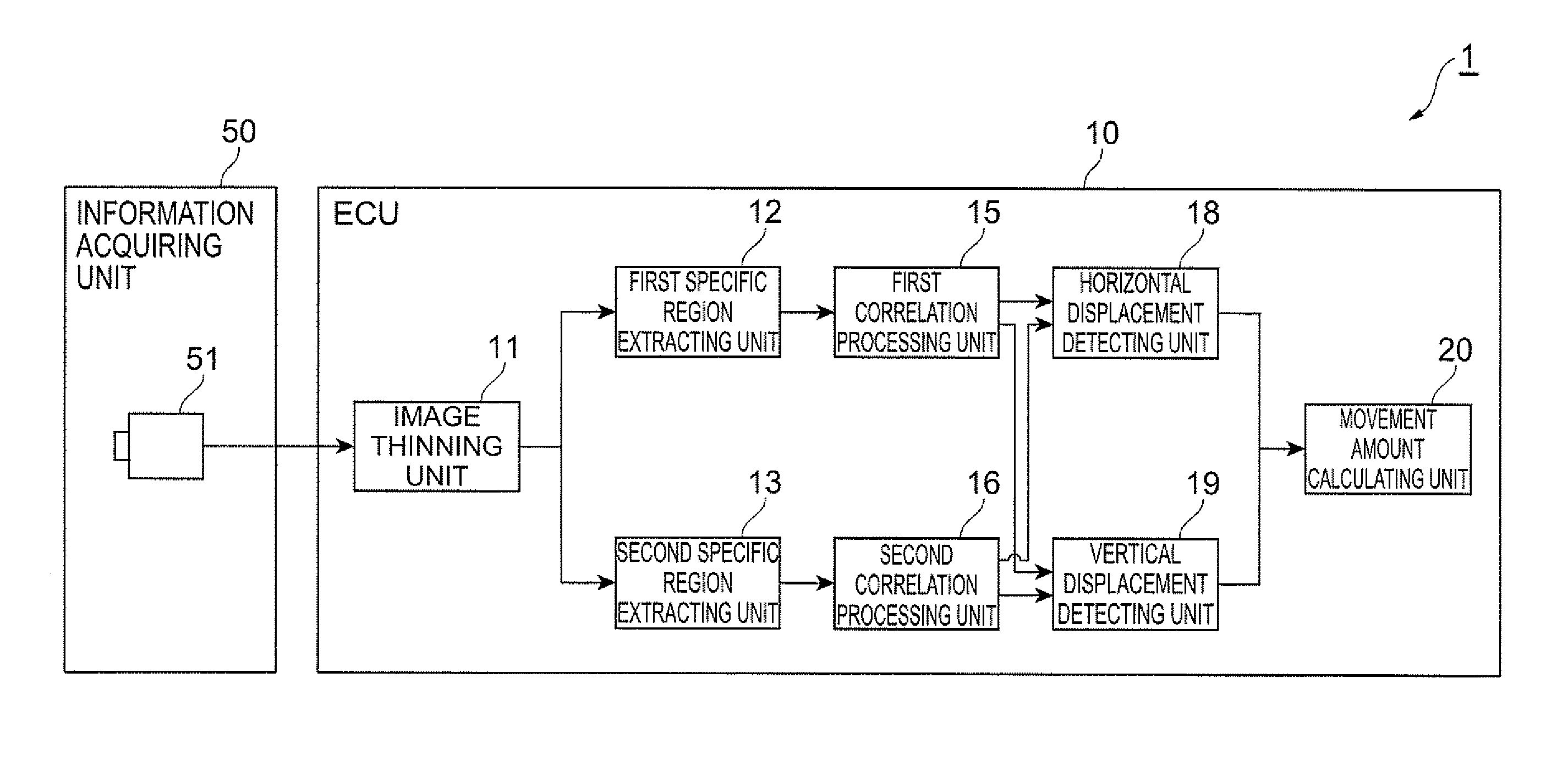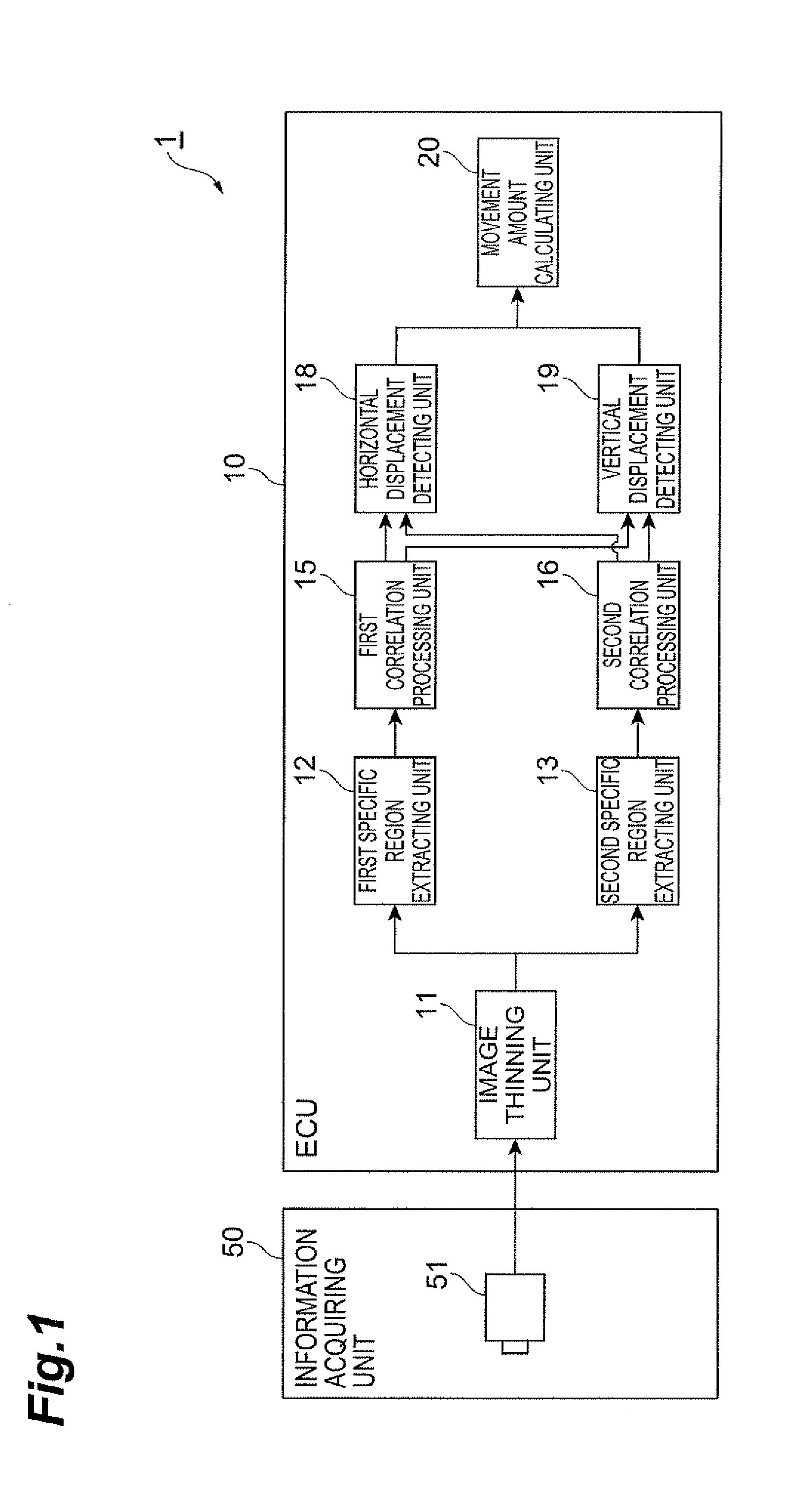On-vehicle image processing device
a technology for processing devices and vehicles, applied in the field of on-vehicle image processing devices, can solve problems such as increasing image processing load, and achieve the effect of accurate correction of telephoto image processing
- Summary
- Abstract
- Description
- Claims
- Application Information
AI Technical Summary
Benefits of technology
Problems solved by technology
Method used
Image
Examples
first embodiment
[0023]FIG. 1 is a diagram schematically illustrating the structure of an on-vehicle image processing device 1 according to a first embodiment of the invention. The on-vehicle image processing device 1 according to this embodiment is applicable to, for example, a drive assist system that acquires the amount of movement of a vehicle from image information and controls the driving of the vehicle.
[0024]As shown in FIG. 1, the on-vehicle image device 1 according to this embodiment includes an information acquiring unit 50 and an ECU 10. The ECU (electronic control unit) is a computer that electronically controls vehicle devices, and includes, for example, a CPU (central processing unit), a ROM (read only memory), a RAM (random access memory), and an input / output interface.
[0025]The information acquiring unit 50 includes a first camera (first imaging unit) 51. The first camera 51 includes an image sensor that acquires the image information of the periphery of a vehicle. For example, a CCD...
second embodiment
[0041]Next, an image processing device according to a second embodiment of the invention will be described.
[0042]An image processing device 2 according to the second embodiment has substantially the same structure as the image processing device 1 according to the first embodiment shown in FIG. 1 except that it includes a third specific region extracting unit 14 and a third correlation processing unit 17. Therefore, in the second embodiment, the same components as those in the first embodiment are denoted by the same reference numerals as those in the first embodiment, and a description thereof will be omitted. The third specific region extracting unit 14 and the third correlation processing unit 17 will be described in detail below.
[0043]FIG. 4 is a diagram schematically illustrating the structure of the image processing device 2 according to this embodiment. The image processing device 2 according to this embodiment includes an information acquiring unit 50 and an ECU 10. The ECU 1...
third embodiment
[0050]Next, an image processing device according to a third embodiment of the invention will be described.
[0051]An image processing device 3 according to the third embodiment has substantially the same structure as the image processing device 1 according to the first embodiment shown in FIG. 1 except that it includes a second camera (second imaging unit) 52 and an image correcting unit (first correcting unit) 22. Therefore, in the third embodiment, the same components as those in the first embodiment are denoted by the same reference numerals as those in the first embodiment and a detailed description thereof will be omitted. The second camera 52 and the image correcting unit 22 will be described in detail below.
[0052]FIG. 5 is a diagram schematically illustrating the structure of the image processing device 3 according to this embodiment, FIG. 6 is a diagram illustrating an example of the arrangement of an information acquiring unit 50 of the image processing device 3 according to ...
PUM
 Login to View More
Login to View More Abstract
Description
Claims
Application Information
 Login to View More
Login to View More - R&D
- Intellectual Property
- Life Sciences
- Materials
- Tech Scout
- Unparalleled Data Quality
- Higher Quality Content
- 60% Fewer Hallucinations
Browse by: Latest US Patents, China's latest patents, Technical Efficacy Thesaurus, Application Domain, Technology Topic, Popular Technical Reports.
© 2025 PatSnap. All rights reserved.Legal|Privacy policy|Modern Slavery Act Transparency Statement|Sitemap|About US| Contact US: help@patsnap.com



